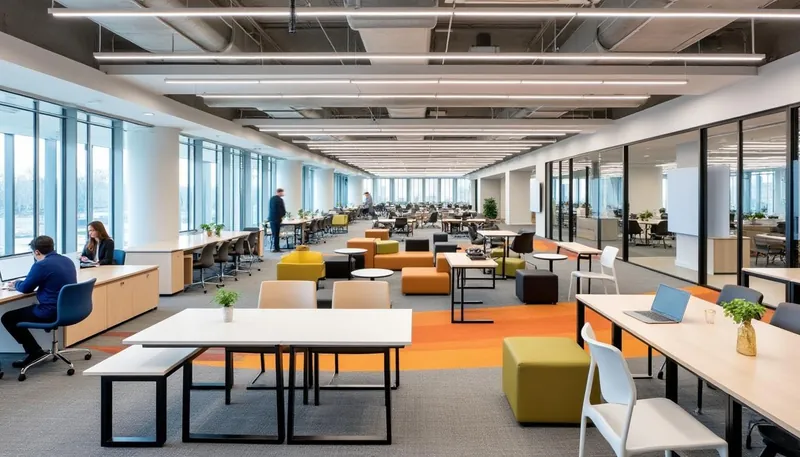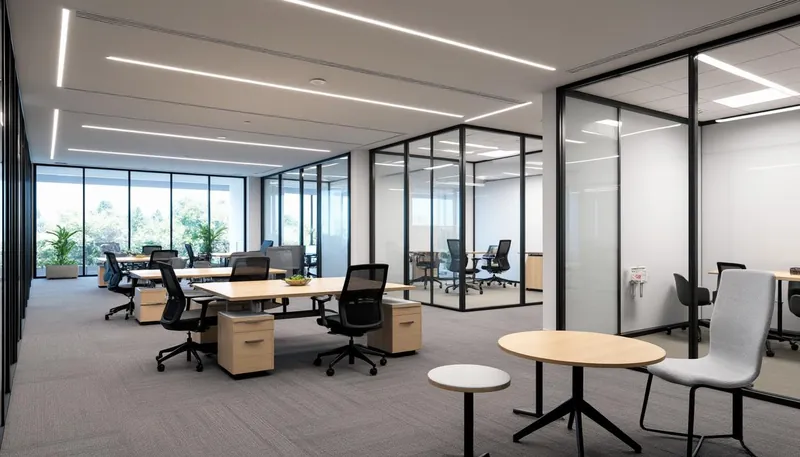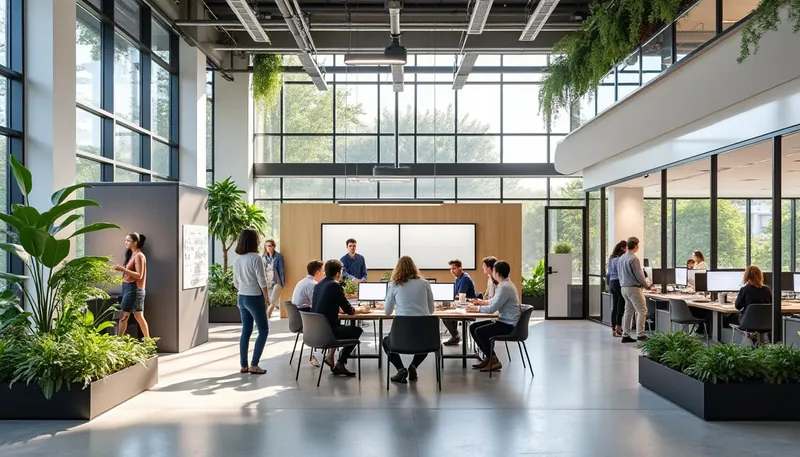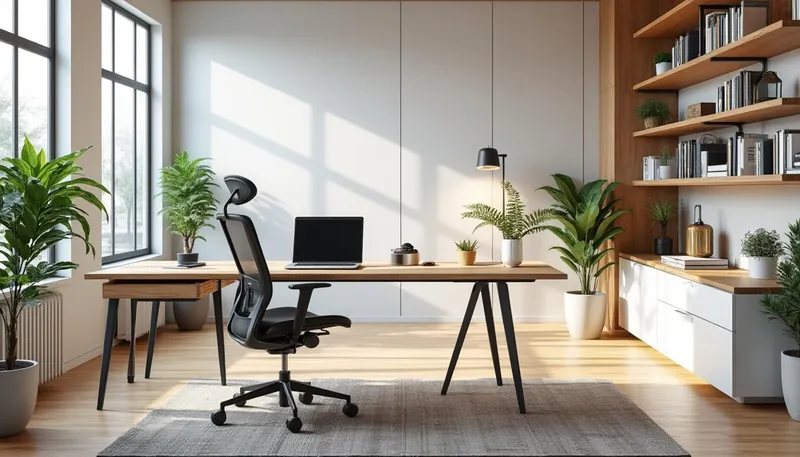In the ever-evolving landscape of the modern workplace, the challenge of creating effective collaboration zones while retaining focused work areas has become paramount. As companies increasingly embrace the dynamic of open-plan offices, the need to balance the vibrancy of collaborative spaces with the quietude required for concentration has never been more critical. This delicate act of design is not merely about aesthetics; it’s about cultivating a work environment that maximizes productivity and fosters a culture of innovation. Achieving this balance involves understanding the types of collaboration, spatial design principles, furniture selection, and the integration of modern technology. Let’s dive deeper into the strategies for implementing successful collaboration zones without compromising the sanctity of focus areas.
Brief
- 🏢 Create dedicated collaboration zones with specific design elements.
- 🔊 Implement acoustic design to manage noise levels.
- 💺 Focus on ergonomic furniture that supports comfort.
- 🌿 Incorporate biophilic design to enhance well-being.
- 🔌 Integrate advanced technology for seamless collaboration.
Understanding Collaboration Types and Designing for Collaboration
Before embarking on the design of collaboration zones, it’s crucial to first appreciate that collaboration takes on various forms, each with unique environmental needs. By recognizing these different types of collaborative work, we can create spaces that enhance team productivity and creativity.
One prominent aspect of collaboration is brainstorming and ideation. These creative sessions thrive in open, energizing spaces where ideas can flow freely. Think writable walls, flexible seating arrangements, and ample natural light that fosters creativity. Utilizing innovative furniture solutions from leading brands like Steelcase, Herman Miller, or Knoll can transform these spaces into vibrant hubs of activity. The energy in such environments can be infectious, sparking creativity and driving ideation. Designers can make use of dynamic color schemes and adjustable elements that can be reconfigured as needed.
Moving to focused team work, the environment calls for a different approach. Here, teams require structured settings equipped with task-specific lighting, comfortable seating, and minimal distractions. It’s vital for these areas not to be located adjacent to high-traffic collaboration zones to reduce noise interference. The design should cater to both digital and analogue work methods, allowing team members to seamlessly interact with various tools. Ergonomic solutions from companies such as Haworth and Vitra can provide the necessary support for extended work sessions.
Another significant category is presentation and review spaces. These areas must accommodate both presenters and audiences, featuring clear sightlines and state-of-the-art technology integration. For instance, utilizing meeting rooms equipped with advanced AV systems can facilitate effective communication and collaboration during presentations, enabling teams to visualize ideas without losing the effect due to poor layout.
| Type of Collaboration | Design Considerations | Furniture Solutions |
|---|---|---|
| Brainstorming & Ideation | Open spaces, dynamic seating, natural light | Writable walls, flexible furniture |
| Focused Team Work | Structured layout, minimal distractions | Ergonomic seating, adjustable desks |
| Presentation & Review | Clear sightlines, technology integration | AV systems, configurable seating |
Understanding these collaboration types fundamentally shapes how we design and utilize the space around us. As research indicates, teams perform up to 35% better when operating in spaces tailored to their collaborative activities. This statistic underlines the importance of thoughtful, deliberate design in optimizing team functions and fostering creativity.

Spatial Design Fundamentals: Optimizing Layout for Collaboration and Focus
The layout of collaboration zones plays a significant role in productivity. In order to create environments where teams can work effectively, it is essential to strategically consider the proximity and accessibility of these spaces. They should be easy to access from individual workstations without causing disruption. For example, situating collaborative zones near cafeterias or lounges can encourage spontaneous interactions, nurturing a sense of community while ensuring that quieter focus areas are preserved.
Another important aspect is the size and scale of the collaboration zones. Different team sizes require various spatial arrangements. Intimate settings for small teams should be designed to promote close interaction, while larger spaces must facilitate engagement among a greater number of individuals. For optimal functionality, consider designing a range of spaces that can accommodate both small brainstorming groups and larger presentations.
Visual and physical boundaries help in defining collaborative zones without completely isolating them—a critical feature in open plan offices. By employing furniture arrangements, flooring changes, and creative lighting solutions, it’s possible to create distinct areas while still maintaining a visual connection to the broader workspace. This balance ensures team members feel a part of a larger community without sacrificing their own territories.
| Design Consideration | Importance |
|---|---|
| Zone Proximity & Accessibility | Encourages spontaneous interactions |
| Size & Scale | Supports different group dynamics |
| Visual & Physical Boundaries | Defines spaces while promoting openness |
Approaching spatial design from these angles not only enhances usability but also instills a sense of belonging and efficiency amongst team members.

Furniture Selection: Influencing Collaborative Effectiveness
The success of collaboration zones is greatly influenced by the choice of furniture and its arrangement within the designated area. Introducing flexible and modular systems is key. These can be adapted quickly to cater to varying group sizes and activities. Consider investing in movable furniture such as mobile tables and stackable chairs. These allow teams to customize their space as needed, creating an environment that is dynamic and conducive to collaboration.
Additionally, providing multiple work surface options is essential. Different tasks demand different heights, and work surfaces that accommodate this variability can significantly enhance productivity. For example, standard height tables facilitate laptop work, while standing-height surfaces can invigorate brainstorming sessions. Integrating writable surfaces such as whiteboards or flip charts for spontaneous idea capture fosters a culture of creativity.
Storage solutions are equally vital. Collaborative activities tend to generate materials and documents that require temporary storage. By including mobile storage units and wall-mounted systems within work areas, clutter can be significantly reduced, allowing team members to maintain their focus on the task at hand. The presence of effective storage helps to ensure the workspace remains organized and efficient.
| Furniture Type | Purpose |
|---|---|
| Round Tables | Encourages equal participation |
| Height-Adjustable Surfaces | Supports both sitting and standing work |
| Writable Walls | Facilitates visual thinking and idea capture |
Choosing the right furniture vendors is just as important. Brands like Teknion, Allsteel, and Kimball provide innovative solutions designed specifically for collaboration spaces. Ensuring comfort and engagement through thoughtful furniture choices can dramatically transform how teams interact and achieve their goals.
Acoustic Design: The Sound of Successful Collaboration
Managing sound is crucial in collaborative environments. These spaces must facilitate communication while preventing disruptions. Effective acoustic design often involves controlling ambient sound to allow for natural conversation levels without allowing for distracting echoes. The use of sound-absorbing materials like acoustic panels and soft furnishings can enhance the auditory experience within the workspace.
Furthermore, intentional placement of acoustic barriers can create ‘speech privacy bubbles’. This ensures teams can communicate freely without feeling exposed to surrounding noise. Integrating white noise systems also helps to mask unwanted sounds while maintaining an inviting atmosphere. It’s this balance that makes collaboration effective, allowing ideas to flow without overwhelming background distractions.
Incorporating technology further enhances acoustic design. As many collaborative activities involve video conferencing and presentations, spaces should be designed to support these functions. This may include optimizing speaker arrangements and incorporating sound technology that minimizes feedback and echoes, ensuring clarity during discussions.
| Acoustic Design Element | Effect |
|---|---|
| Sound-Absorbing Materials | Reduces reverberation and noise disruption |
| Strategic Acoustic Barriers | Enhances speech privacy |
| Technology Integration | Supports clear communication in meetings |
By prioritizing acoustic considerations, employers can create environments that not only support collaborative endeavors but also respect the need for focused work, striking the perfect balance.
Integrating Technology: A Seamless Experience for Collaboration
In today’s digital age, seamless technology integration is essential for enhancing collaborative experiences. Effective collaboration relies on reliable internet connectivity, sufficient power outlets, and optimal hardware for presentations and communication. Ensuring that each collaborative zone is well-equipped with these resources allows team members to focus on their tasks without the frustration of technical difficulties.
Providing high-speed internet access is imperative. It is worth investing in robust bandwidth packages from providers like Office Depot, ensuring that all members can utilize the technology they need without interruptions. Additionally, having multiple display options such as interactive whiteboards not only enhances content sharing but also fosters collaborative discussions that can lead to innovative solutions.
As more workplaces adapt to a hybrid model, collaborative zones must support this dynamic as well. This could include installing designated spaces outfitted for video conferencing, complete with integrated audio-visual systems to ensure remote and in-office participants can interact effectively.
| Technology Element | Impact on Collaboration |
|---|---|
| Power Outlets | Facilitates uninterrupted work |
| WiFi Connectivity | Enables seamless digital communication |
| Video Conferencing Tools | Supports hybrid communication |
The future of collaboration is digital, and ensuring your workspaces are equipped to handle these demands will significantly enhance overall productivity and engagement.
What should be the first step in designing collaboration zones?
Understanding the various types of collaboration and their specific needs is key. This allows designers to create spaces that cater to the unique dynamics of team work.
How can acoustics impact collaboration?
Good acoustic design helps in minimizing distractions while enabling effective communication amongst teams.
Which brands offer innovative solutions for collaborative furniture?
Brands like Steelcase, Herman Miller, Knoll, and Teknion provide a range of solutions tailored for collaboration.
Is technology essential in collaborative spaces?
Yes, technology integration is crucial to enhance communication, facilitate presentations, and provide a seamless collaborative experience.
What is the significance of ergonomic furniture in workspaces?
Ergonomic furniture promotes comfort, reduces strain, and supports productivity during long working sessions.

